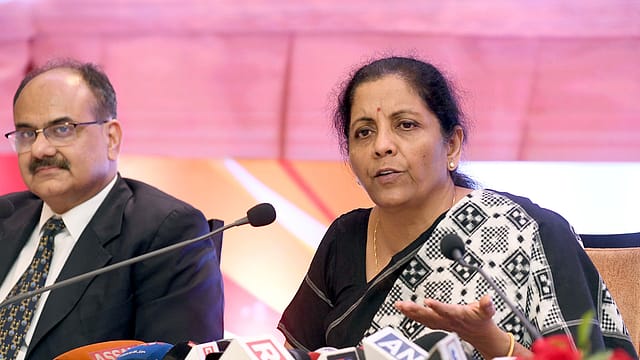The road to ₹1.05 trillion disinvestment target
ADVERTISEMENT

In her maiden Budget speech of FY 20, Finance Minister Nirmala Sitharaman had laid out a detailed road map to achieve the disinvestment target of ₹1.05 Lakh crore—the highest in India’s history. “Strategic disinvestment of select central state public sector enterprises would continue to remain a priority of this government. In view of current macro-economic parameters, Government would not only reinitiate the process of strategic disinvestment of Air India, but would offer more central public sector enterprises for strategic participation by the private sector,” she had said.
While many critics believe that it is near impossible to meet the new target, it may not be so if you look at the track record of the government. Last year, as on March 31, 2019, the government had realised ₹84,972 crore as against the budgeted estimate of ₹80,000 crore. Similarly, the total disinvestment proceeds during 2017-18 were ₹1,00,056 crore vis-a-vis the revised target of ₹1,00,000 crore. Total disinvestment proceeds for FY17 were R₹46,246.58 crore. So, meeting the new target is not an impossibility but there is a little hitch.
It may not be so easy for the government to find strategic investors. However, the government believes that there are enough suitors for both profit-making Bharat Petroleum and the loss-making Air India. The government also believes that global oil majors like Saudi Aramco are waiting in the wings to get an entry into the Indian market. But in the past, the disinvestment target was achieved by one CPSE buying stakes in the other. For instance, in FY18, Oil and Natural Gas Corporation acquired a 51% stake in Hindustan Petroleum for ₹36,900 crore, and helped the government garner a record ₹1 trillion in divestment proceeds. Similarly in FY19, Power Finance Corp acquired a 52.63% stake in Rural Electrification Corp for ₹14,500 crore.
January 2026
Netflix, which has been in India for a decade, has successfully struck a balance between high-class premium content and pricing that attracts a range of customers. Find out how the U.S. streaming giant evolved in India, plus an exclusive interview with CEO Ted Sarandos. Also read about the Best Investments for 2026, and how rising growth and easing inflation will come in handy for finance minister Nirmala Sitharaman as she prepares Budget 2026.
The government’s disinvestment’s strategy seems to rest on four pillars. These include the strategic sale of public sector units to the private sector (strategic sale), consolidation of the non-financial central public sector enterprises (CPSEs), equity stake sale in CPSEs, even where the government’s stake falls below 51%, but continues to retain control. However, such a move will not mean the government exercising its “golden share”, which gives it the right to veto any move by the new owners. Moreover, the government can sell part of its equity holdings in select PSUs to a fund company which runs an Exchange Traded Fund or CPSE-ETF. By diluting its equity stakes in the ETF, it can raise the necessary funds. Last year the government raised ₹17,000 crore through this route.
Finally, the fog around the disinvestment is starting to clear. After all, till September end, the government had just raised ₹17,364 crore and the ₹1.05 lakh crore target seemed a little far fetched. But the recent announcements by the cabinet has given some hope. The finance minister said that the crude refining and marketing major, Bharat Petroleum Corporation Limited (BPCL), and the ailing national airline Air India will be put up for strategic sale in this financial year.
Interestingly enough, the government does not want to give up BPCL’s 61% stake in the Numaligarh refinery. This the government said will be offered to a public sector oil and gas company. Similarly, in the case of public sector inland transport major , Container Corporation of India (Concor), the government wants to offload 30.8% of its stake to a strategic investor along with management control, but will continue to retain 24% stake. it is expected to fetch the government ₹13,000 crore. So the sale of BPCL, Shipping Corporation of India and Concor is likely to fetch nearly ₹63,000 crore to the exchequer.
The reason for retaining the stake in Concor, explained the finance minister, was because the company was integrally linked to the Indian Railways. “We don’t really have a very competitive market as yet in this area, so therefore, it is important that the government retain stake that is less than 26%. Therefore is no veto thing, ’’ said the minister after the crucial cabinet meeting on November 20, 2019.
After failing to sell the debt-laden national airline last year, the government is willing to substantially reduce the airlines debt to make it lucrative for the new buyer. Though there is still no clarity on what the government expects from the deal; it has made it clear it will not only sell the airline but also its five subsidiaries.
The recent cabinet meeting also clarified the government’s willingness to sell its entire 53.3% stake in BPCL, which could fetch the government ₹63,000 crore at today’s current market capitalisation. Moreover,the government hopes to offload the entire 74.2% stake of Tehri Hydro Development Corporation and North Eastern Electric Power Corporation to the state-run National Thermal Power Corporation.
Finally, the government has yet to decide on the CPSEs, where it wants to bring down its stake to less than 51%. That too can become a money spinner. The process has begun and now whether the government can achieve its target will depend on the speed of implementation.
